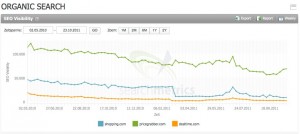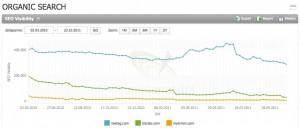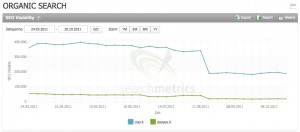In the past week, a document with the title “General Guidelines Version 3.18 March 30,2011” was leaked, that essentially dealt with the evaluation of websites. Though it is obviously directed at search engine raters, it should not be understood that it is necessarily used to train Google raters. However, since Google rather quickly and forcefully tried to prevent the publication of the document, this could be taken as an indication that it might be… (Info: Searchengineland, Potpiegirl).

- Anyway, it doesn’t really matter. I don’t want to summarize the 125 pages here – that would be far too ambitious an undertaking. However, I would like to establish a link between those guidelines and the reality of what we’re dealing with, which is quite explicitly the theme of ‘spam detection’. And in connection with the Panda update, the question keeps coming up as to why some ‘thin’ affiliate pages were trampled by Panda while others were not.
- So, getting down to the details! In the guidelines a ‘thin affiliate’ is essentially described as a website that earns money from affiliate agencies and that exists only to earn money. A ‘thin affiliate’ offers no extra value and doesn’t help users in any way. So far that’s pretty easy to understand.
Who are these ‘thin affiliates’?
But it also says that all affiliates are not necessarily ‘thin’. A few domains are described quite precisely that, while living from affiliate agencies, still offer some value. For example, sites with price comparisons, product reviews, lyrics, recipes etc. Here are the visibility curves of the affiliate sites identified in the document:




Simply take a look for yourself at the sites in Essentials — free of charge.
Indeed most of the mentioned sites seem to have survived the various Panda Updates relatively well. There are only a few cases where the authors of the guidelines and the Google Panda algorithm are not in agreement. This is quite interesting in itself and an additional indicator that the guidelines really did come from Google…
So how do you tell the difference between a ‘thin affiliate’ and a shop?
In any case it seems that these guidelines are a training manual and, as such, should include advice for distinguishing a ‘thin affiliate’ from a real shop. And indeed, the following tips or something similar are given to raters as a way of identifying real shops:
- the presence of a functioning calculator for delivery charges
- a functioning forum
- links to a shopping basket that open at the same domain
- a wish list function and/or the ability to save purchases for later
- an option to login or register
The direction here is clear. Only sites in real contact with their users will be above suspicion as ‘thin affiliates’. Which all seems quite logical to me…
What do you think? Have you also read the document and what did you take from it?
